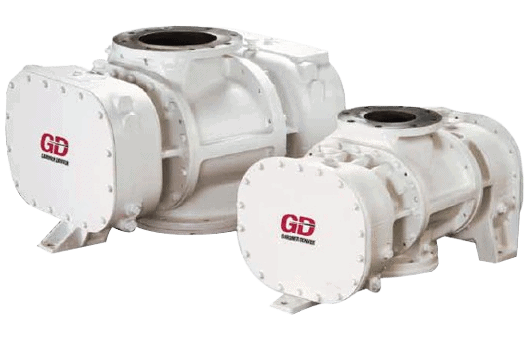Business
7 Features to Look for When Buying a Positive Displacement Blower

Choosing the right positive displacement blower is important for many industries, like wastewater treatment, aeration, and moving materials. These machines must work well and be reliable, but for that, you must know what features to look for. Below are eight important things to think about before buying a positive displacement blower. These points will help you find a device that is reliable, affordable, and fits your needs.
- Flow Rate and Pressure Capacity
The flow rate tells you how much air Positive Displacement Blowers can move, usually shown in cubic meters per minute or cubic feet per minute. It’s important that the blower can move enough air to match what your system needs, but not too much, or you’ll waste energy. Pressure capacity shows how well it can push air through pipes or filters, especially if there are blockages or resistance.
If your system has a lot of backpressure, you’ll need a blower that can handle it without burning out or overheating. Reliable brands usually share “performance curves” to show how flow and pressure change together. Checking these details makes sure you don’t pick one that is too small, or too powerful, for the job.
- Energy Efficiency and Power Consumption
The cost of running industrial machines is mostly from the electricity they use. Energy-efficient blowers use less power, saving you money over time. The type of motor and the way it’s built affect how much energy is used. Some blowers let you change their speed to match what’s needed, so they’re not always running full blast when it’s not needed.
Using things like variable frequency drives can help cut down electricity costs. Look at efficiency ratings and compare different products to pick the one that will save the most energy. This also helps if your company wants to be more eco-friendly.
- Construction Materials and Durability
The materials used to make the blower play a role, especially if it will be exposed to water, chemicals, or a lot of dust. Cast iron, aluminum, and stainless steel are common. Each of these has strengths depending on where you’ll use the blower.
Parts that get wet or touch chemicals need coatings or need to be made from special metals to avoid rust or corrosion. Because the inside parts are moving and may get hot, they need to be tough so they don’t wear out quickly. Good materials may cost more at first, but they make the unit last longer and need fewer repairs.
- Noise Levels and Vibration Control
Blowers can be noisy, and too much noise isn’t safe or comfortable in a workplace. Low-noise models have extra covers or insulation to keep things quiet and may follow workplace safety rules. Vibration is another issue that you should take into account.
For example, if the blower shakes too much, it can damage itself or move around. Some blowers are balanced better or use special mounts to absorb vibration. Keeping noise and the vibration low helps your equipment last longer and makes the work area nicer.
- Maintenance Requirements and Ease of Servicing
Any machine needs regular care to run well. Some blowers are designed so you can easily get to filters, oiling spots, or inspection panels. This makes it quicker to check and keep them clean or replace worn parts like seals or bearings.
If you can replace these parts without taking apart the whole machine, it saves time and money. A good blower will come with clear instructions about what needs caring for and how often. Picking a device with simple maintenance needs cuts down on long-term work and cost.
- Sealing Mechanism and Leak Prevention
Air leaks make the blower less efficient and force it to work harder. Seals keep air from escaping and stop dirt from getting into the system. Blowers may have different kinds of seals, like lip seals or mechanical ones, depending on where and how it’s used. Seals can also keep oil or grease from getting into the air if the unit needs lubrication. Good sealing technology means you won’t lose airflow or waste energy due to leaks.
- Temperature and Environmental Compatibility
Where the blower will run matters a lot. In hot, humid, dusty, or chemical-heavy areas, the device has to be built for that. Some have extra cooling systems to stop overheating if they’re used for long hours. If dust or chemicals are a problem, look for special housings or materials that won’t rust.
High or low temperatures might also change the way lubricants work, which can affect moving parts. Be sure the unit is rated for the climate and conditions of your job site, and check for things like IP ratings, which show how well it keeps out dust and water.
To choose the best Positive Displacement Blowers, look at technical specs and how the way in which it will be used. Thinking about things like efficiency, strength, and how easy it is to control will help you choose a machine that’s dependable and not too expensive in the long run. Comparing several options gives you a better chance at finding the right match for your needs.
Business
Best Refurbished Phones Under $200 in Australia

Even on a tight budget, you can find phones that combine quality and reliability.
Affordable Smartphones That Still Deliver
Let’s be honest spending over $1,000 on a brand-new phone isn’t for everyone. Most of us just need something that calls, texts, browses, and runs our favourite apps without lag. That’s where refurbished phones under $200 come in; they give you reliable performance without the steep price tag.
And in Australia, one of the best places to find these deals is Mobile Guru. Their curated collection of affordable refurbished smartphones proves that “budget” doesn’t have to mean “basic.”
Why Refurbished Phones Are Worth a Second Look
Refurbished phones aren’t just “used” devices. Every device is professionally cleaned, tested, repaired (if needed), and certified to ensure it works like new. You’re essentially getting a phone that performs well for a fraction of the original cost.
Here’s why they’re a smart buy:
- Save Big: Popular models like the iPhone 8 or Galaxy S10 are available for under $200.
- Reliable Quality: Certified refurbished means every key function camera, speaker, battery is checked before sale.
- Eco-Friendly Choice: You’re helping reduce e-waste by giving a quality device a new life.
- Australian Local Warranty & Support: When buying from Mobile Guru, you’re covered by local warranty and express shipping within Australia, making the process easy and risk-free.
Top Picks: Best Refurbished Phones Under $200
Apple iPhone 7 (Refurbished)
Still a solid performer, the iPhone 7 is perfect for anyone who wants Apple reliability on a tight budget. It features a 12MP rear camera, a sharp Retina HD display, and Touch ID for easy access.
Why it’s worth it:
- Compact and comfortable design
- Smooth iOS performance
- Ideal for calls, social media, and streaming
You’ll often find the refurbished iPhone X listed under $200 on Mobile Guru, making it a favourite among budget-conscious Apple fans.
Apple iPhone 8 (Refurbished)
For those who want a bit more power, the iPhone 8 still feels modern thanks to its glass back, wireless charging, and A11 Bionic chip. It runs the latest iOS versions smoothly and looks premium without the premium price.
Why it’s worth it:
- Great daily performance
- Reliable camera quality
- Wireless charging support
For a “like-new” Apple experience under $200, the iPhone 8 is a clear winner.
Samsung Galaxy S10 (Refurbished)
The Samsung Galaxy S10 was a flagship device when it launched and it still delivers impressive performance today. With its stunning Infinity-O AMOLED display, fast processor, and premium build, it offers excellent value for budget buyers.
Why it’s worth it:
- Brilliant edge-to-edge AMOLED display
- Smooth performance for multitasking and apps
- Premium glass and metal design
- Great camera setup for everyday photography
You can often find certified refurbished S10 models at Mobile Guru for under $200, making it a top pick for anyone who wants flagship features without the flagship price.
Samsung Galaxy S7 (Refurbished)
Once Samsung’s flagship, the Galaxy S7 still holds up remarkably well. Its compact design, crisp Super AMOLED display, and water resistance make it a surprisingly capable all-rounder.
Why it’s worth it:
- Premium feel and performance
- Excellent camera for its age
- Water and dust resistant
Even years later, the S7 delivers flagship quality for a fraction of the cost — a real gem under $200.
Google Pixel (Refurbished)
For Android purists, the original Google Pixel is hard to beat. Known for its smooth software and incredible camera, it’s ideal for everyday browsing, photography, and simple app use.
Why it’s worth it:
- Clean Android experience
- Excellent low-light camera performance
- Ideal for minimalists who value speed and simplicity
You’ll often find refurbished Pixel models under $200 at Mobile Guru, offering premium performance on a budget.
Tips for Choosing the Right Refurbished Phone
Before you buy, keep these quick tips in mind:
- Check the Grade: Grade A looks almost new, while Grade B or C may have minor marks (but still work perfectly).
- Look for Warranty: Always choose sellers like Mobile Guru that offer 24 Months warranty and easy returns.
- Unlocked Devices: Make sure the device is unlocked for use with any Australian SIM.
- Battery Life: A trusted refurbisher tests and replaces weak batteries before listing.
Budget-Friendly Doesn’t Mean Compromise
Refurbished phones under $200 prove that great tech doesn’t have to be expensive. Whether it’s an iPhone, a Samsung, or a Google Pixel, you can enjoy solid performance, quality design, and everyday reliability all without overspending.
Explore the under-$200 range at Mobile Guru and discover how much value you can get from a refurbished device that still feels brand new.
Business
Navigating Sydney’s Market: Insights from a Commercial Real Estate Expert

Understanding the intricacies of the commercial real estate market in Sydney is critical for businesses looking to invest or expand in this bustling metropolis. Sydney, known for its thriving economy and vibrant lifestyle, offers a wide array of opportunities for investors. Consulting with a commercial real estate expert in Sydney can provide invaluable guidance and insights into making informed decisions in this competitive market.
The Dynamics of Sydney’s Commercial Real Estate Market
The commercial real estate market in Sydney is characterised by its dynamic nature and is influenced by various economic factors. Over the past decade, the city has experienced significant growth, driven by an influx of international businesses and local entrepreneurs. This growth has led to increased demand for office spaces, retail properties, and industrial sites.
Sydney’s diverse economy, which includes sectors such as finance, technology, and education, has played a vital role in shaping the commercial real estate landscape. Businesses in these sectors often require high-quality office spaces, leading to a steady demand in key areas like the Central Business District (CBD) and burgeoning suburbs.
Key Areas for Commercial Investment
The Central Business District remains a prime location for commercial investment due to its accessibility and prestigious address. However, other areas in Sydney are also gaining popularity among investors. Suburbs such as Parramatta, North Sydney, and the Western Sydney region have seen substantial development in recent years.
Parramatta, often referred to as Sydney’s second CBD, offers a less costly alternative with numerous development projects underway. North Sydney provides a blend of urban convenience and a more relaxed atmosphere, while Western Sydney is emerging as a hub for logistics and distribution businesses.
Challenges in the Sydney Market
Despite the growth opportunities, there are several challenges associated with the Sydney commercial real estate market. High property prices and limited availability of prime locations can pose significant hurdles for investors and businesses alike. Furthermore, navigating the legal and regulatory requirements in Sydney can be complex and time-consuming.
These challenges underscore the importance of engaging with a knowledgeable commercial real estate expert who can offer strategic advice and support throughout the investment process.
The Role of a Commercial Real Estate Expert
A commercial real estate expert can provide comprehensive market analysis, helping investors to identify lucrative opportunities while avoiding potential pitfalls. Their expertise extends beyond property selection and includes negotiating leases, understanding zoning laws, and managing transactions smoothly.
These professionals are adept at anticipating market trends, ensuring that clients capitalise on emerging opportunities and navigate challenges effectively.
Trends Shaping the Future of Sydney’s Commercial Real Estate
The landscape of Sydney’s commercial real estate is constantly evolving, shaped by trends such as the rise of co-working spaces and the integration of sustainable practices. Co-working spaces have become increasingly popular among start-ups and freelancers, offering flexible and cost-effective office solutions.
Moreover, sustainability has become a crucial factor for many businesses, driving demand for buildings that meet high environmental standards. Experts predict that these trends will continue to influence the market in the years to come.
The Impact of Technology on Real Estate
Technology is playing a transformative role in the commercial real estate sector by enhancing property management and client interactions. Innovations in digital platforms are streamlining processes, making transactions more efficient, and offering sophisticated analytics that help in decision-making.
Virtual tours and augmented reality tools are also revolutionising how properties are marketed and viewed, offering potential tenants and investors a more immersive experience.
Strategies for Successful Investment
To succeed in Sydney’s commercial real estate market, investors must adopt well-informed and strategic approaches. This involves thorough research into market conditions, understanding tenant needs, and staying ahead of industry trends.
Partnering with a seasoned commercial real estate expert is crucial, as their advice can significantly impact investment outcomes, ensuring profitable and sustainable ventures.
Conclusion
Sydney’s commercial real estate market offers significant opportunities for growth and investment. By leveraging the expertise of seasoned professionals and staying informed about market dynamics and emerging trends, investors can navigate the challenges and capitalise on the potential that Sydney has to offer.
The role of a commercial real estate expert in Sydney is indispensable in guiding businesses and investors through the complexities of this vibrant market.
Business
Expert Insights: Choosing the Best Class 2 Builder in Sydney for Remedial Building Services

When it comes to choosing a Class 2 Builder in Sydney, it is crucial to consider several factors that can impact the quality and success of your remedial building projects. Class 2 Builders are responsible for constructing and modifying certain types of buildings, including residential and mixed-use buildings. Their role is critical in ensuring structural integrity and compliance with current building codes.
Sydney, known for its ever-evolving skyline and innovative architecture, requires builders who not only understand construction but also compliance with strict regulatory standards. Here, we delve into the aspects you need to consider when selecting a Class 2 Builder for your remedial building services in Sydney.
What is a Class 2 Builder?
A Class 2 Builder is licensed to work on residential buildings that typically contain two or more apartments. These buildings are often complex structures requiring substantial expertise to ensure they meet all legal and safety standards. The focus of Class 2 Builders lies predominantly within high-rise developments, so their expertise can be fundamental when dealing with multi-storey buildings.
Understanding Remedial Building Services
Remedial building services involve the repair and restoration of existing structures. These services are crucial for maintaining the safety, aesthetics, and functionality of buildings. Issues such as water ingress, structural failures, and facade deterioration often necessitate remedial work, requiring a skilled Class 2 Builder for effective solutions.
Licensing and Qualifications
One of the first steps in choosing the best Class 2 Builder in Sydney is ensuring they are properly licensed and qualified. The builder should possess appropriate certifications and be recognised by local building authorities. This not only ensures compliance with building standards but also signifies a commitment to quality and professionalism.
Experience and Track Record
Experience plays a pivotal role in selecting a reliable Class 2 Builder. Look for builders who have a proven track record of delivering successful projects similar to yours. Past performance is often a good indicator of future success, especially in complex remedial construction tasks.
Researching Reputation
A builder’s reputation can tell you a lot about their reliability and quality of work. Seeking testimonials from past clients and checking online reviews can offer insights into customer satisfaction. A well-regarded builder is likely to provide exceptional service.
Understanding Building Codes and Standards
The best Class 2 Builders in Sydney are those who have a thorough understanding of current building codes and standards. They should be able to guide you through the compliance process, ensuring that your remedial building works meet all necessary regulations.
Technology and Innovation
The construction industry is continually evolving, with new technologies and innovative methods emerging regularly. A forward-thinking builder who embraces new technologies can offer more efficient and cost-effective solutions, potentially saving time and money on your project.
Communication and Project Management
Effective communication is essential for the successful completion of any building project. Choose a builder who is transparent in their communications and provides regular updates on progress. Strong project management skills also ensure that timelines and budgets are adhered to.
Sustainability Considerations
Sustainability is increasingly important in construction. Opt for a builder who incorporates environmentally friendly practices. This may include using sustainable materials, reducing waste, and improving the energy efficiency of buildings.
Cost and Budgeting
Your budget is a crucial factor when choosing a builder. While it is important to find a builder whose services are affordable, cost should not be the only criterion. Balancing cost with quality is essential to ensure the longevity and safety of your building.
Getting Quotes and Comparing Services
Before making a final decision, it is advisable to obtain detailed quotes from different builders. This not only helps in comparing costs but also in assessing the scope and quality of services offered. A comprehensive quote will provide a clear breakdown of all expenses involved.
Legal Scrutiny of Contracts
Carefully review the contractual terms proposed by builders. Ensure all agreements concerning work scope, timelines, costs, and responsibilities are clearly defined and documented to avoid potential disputes later on.
Site Audits and Inspections
Conducting site audits and inspections with your prospective builder can provide valuable insights into their methodology and attention to detail. It is an opportunity to assess their approach to safety and quality control.
Ensuring Safety Protocols
Safety should be a paramount concern in any building activity. Verify that your chosen builder follows stringent safety protocols and routines to secure the site and protect both workers and residents.
Conclusion
Choosing the best Class 2 Builder in Sydney for remedial building services involves careful consideration of numerous factors, from licensing and experience to communication and sustainability practices. By conducting thorough research and evaluating potential builders on these criteria, one can ensure a successful and compliant building project.

 Blog10 months ago
Blog10 months agoHow to Deal with Scabies While Traveling

 Travel10 months ago
Travel10 months agoRichmond, Virginia Street Art Guide

 Travel9 months ago
Travel9 months agoPerhentian Islands: How to Get There, What to Expect, & More

 Travel10 months ago
Travel10 months agoHow to Live in Your Car in New Zealand

 Travel9 months ago
Travel9 months agoSouvenir in Nepal: A Guide to Unique Handicrafts and Cultural Treasures

 Travel9 months ago
Travel9 months agoVegan Guide to Dining Out in Richmond, Virginia

 Food9 months ago
Food9 months agoVegetarian Food Nepal: A Journey into Flavorful Plant-Based Cuisine

 Travel6 months ago
Travel6 months agoA Local’s Guide to Sanibel Island, Florida















